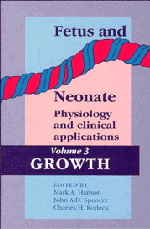Book contents
- Frontmatter
- Contents
- Preface to the series
- List of contributors
- Part I Physiology
- 1 Placental transfer
- 2 Nutrient requirements for normal fetal growth and metabolism
- 3 Hormonal control of fetal growth
- 4 Insulin-like growth factors and their binding proteins
- 5 Metabolism and growth during neonatal and postnatal development
- Part II Pathophysiology
- Part III Clinical applications
- Index
4 - Insulin-like growth factors and their binding proteins
from Part I - Physiology
Published online by Cambridge University Press: 04 August 2010
- Frontmatter
- Contents
- Preface to the series
- List of contributors
- Part I Physiology
- 1 Placental transfer
- 2 Nutrient requirements for normal fetal growth and metabolism
- 3 Hormonal control of fetal growth
- 4 Insulin-like growth factors and their binding proteins
- 5 Metabolism and growth during neonatal and postnatal development
- Part II Pathophysiology
- Part III Clinical applications
- Index
Summary
Introduction
The insulin-like growth factors (IGFs) -I and -II are two single chain polypeptide hormones with marked structural and evolutional homology to each other and to proinsulin. They have molecular weights of 7649 D and 7471 D, respectively. Each is a single chain polypeptide with three intrachain disulfide bonds. Their presence was first suggested by observations that growth hormone (GH) acted to promote tibial epiphyseal growth by means of an intermediate serum factor. This factor was first termed sulfation factor and then somatomedin. Following purification and sequencing it was renamed insulin-like growth factor-I. This term originates, in part, because of its sequence homology to insulin and secondly, because of its spectrum of biological actions. IGF-II was identified following study of insulin-like activity in serum which was not suppressible by insulin antisera (non-suppressible insulin-like activity).
The study of these two peptides, their binding proteins and receptors has exploded in recent years. Their role in embryonic and fetal development has been of particular interest. One particular problem has been the methodological complexities of measurements of components of this axis: this has limited progress. For example, their measurement in plasma requires rigorous extraction and separation from the IGF-binding proteins. Many earlier conclusions have had to be revised as methodological advances have occurred. This chapter will review primarily our current understanding of the IGFs in the regulation of fetal growth.
The IGF axis
IGF-I and IGF-II
Both IGF-I and IGF-II are found in the adult human circulation: the major tissues of origin for circulating IGF-I are muscle and liver.
- Type
- Chapter
- Information
- Fetus and Neonate: Physiology and Clinical Applications , pp. 97 - 116Publisher: Cambridge University PressPrint publication year: 1995
- 1
- Cited by



